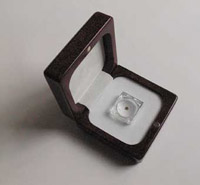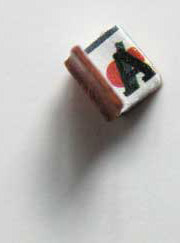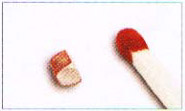|
"The Smallest Book in the World"
A Core Book Review
by Natalie Ng
Book info:
Title: The Smallest Book in the World
Author: Josua Reichert
Publisher: Die Gestalten Verlag, 2002
In Search of Gutenberg
I set out to write the shortest book review in the world, appropriately,
I gathered, on The Smallest Book in the World (Die Gestalten Verlag,
2002; US$110). But then I realized the conceptual nature of the
review would render it somewhat non-printable (I use the term
"printable" loosely to include the electronic version
on the Internet). More importantly, the idea of such a review,
perhaps much like that of its subject, would likely be superior
to the final outcome. Which is not to say, however, it is not
worth the effort, as evidenced by the German typographer Josua
Reichert's latest "book," which invokes a number of
interesting issues pertaining to book design, typography, print
medium, and the current publishing market.
In terms of timing, the release of The Smallest Book is both
logical and odd. It arrived the market at a time when the opposite
extremity in its various manifestations, from the largest conglomerates
to the tallest buildings, in one way or another carry certain
negative associations. The Smallest Book, measuring 2.4mm by 2.9mm,
seems to be very much in sync with the popular consumer aesthetics
and obsession with everything portable and light weight. Yet,
exactly because of the advanced technology in manufacturing and
ubiquitous computing that have made products even more unwieldy
than a traditional set of encyclopedias available in a gadget
the size of a palm, it appears that printing on paper twenty-six
alphabets, which comprise the entire content of The Smallest Book,
as minuscule as possible a rather peculiar mission indeed.
The exclusive fonts designed by Reichert exudes an unmistakable
idiosyncrasy and playfulness. Nevertheless, readers would more
likely find themselves overwhelmed less by the uniqueness of the
fonts than by all that meticulousness going into presenting the
content. If there is a case to be made about judging a book by
its cover, or in this case, the case, this is it. Delicately safeguarded
under a square of magnifying glass centered in a polished mahogany
wood box with four green felt cushion dots precisely place at
the corners of the underside, the leather-bound, full-color illustrated
edition, manufactured in the traditional book city, Leipzip, Germany,
bears all the traits of an exquisite item for collectors.
But since more writing has been scripted on less word-friendly
tiny surfaces (e.g. a grain of rice), to lump the diminutive book
with other miniature collectibles, one would risk missing a quaint
statement -- perhaps quite inadvertently made -- hidden somewhere
between the lines of A and Z. It's a statement that may not call
for tracing the print history all the way back to Gutenberg, though
one would almost certainly benefit from it.
Unlike the usual suspects coveted by bibliophiles, for instance,
first editions and autographed copies bearing a patina of age,
The Smallest Book emanates a distinct, if confounding, aura --
and let's not forget re-definition of aura has come a long way
since Walter Benjamin's 1955 essay "The Work of Art in the
Age of Mechanical Reproduction" -- one that is layered with
ambivalence indicative of the state of art book publishing in
the new media age. The Smallest Book is at once the epitome and
the antithesis of its form; it's a curious thing due in no small
part to its dogged insistence of the book form and the time honored
tradition of the art of printing and bookbinding belonging to
an bygone era. Yet, more tellingly, when the print medium has
been relegated -- or elevated, as some would argue -- to the status
of sheer collectibles, when the print form attempts to evade its
increasing irrelevance by emulating, at times wrong-headedly,
its digital counterpart such as a microscopic computer chip, it
doesn't take a good deal more than twenty-six alphabets to spell
out the message that is, literally, the medium.
|
|



|